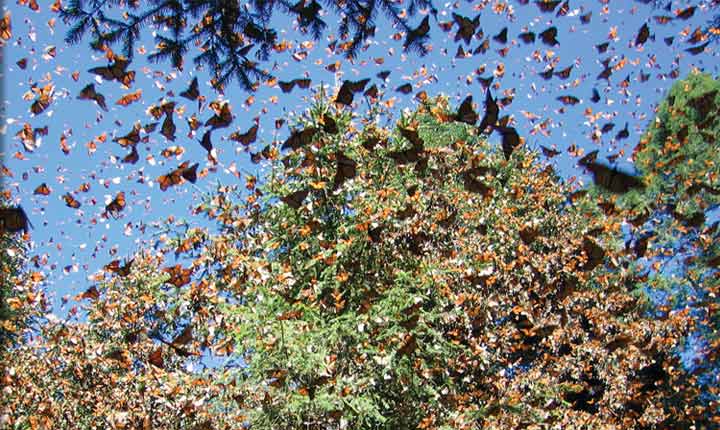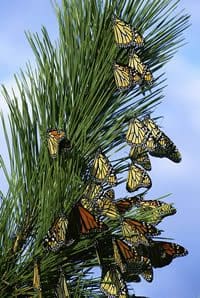
In the central highlands of Mexico, about four-hour’s drive from Mexico City, one of nature’s most intriguing mysteries replays a stunning spectacle every November. The sky becomes a fluttering, shimmering orange as hundreds of millions of monarch butterflies complete their 3,000 mile migration from southern Canada and the northeastern U.S. They descend on the same sanctuaries of oyamel fir forests year after year like clockwork. Invariably, the monarchs’ return to their ancestral wintering grounds coincides with the celebration of El Dia de los Muertos, or the Day of the Dead.
Is the timing of the annual migration a mere coincidence? Throughout Mexico, All Saints Day (November 1) and All Soul’s Day (November 2) celebrations honor loved ones who have left the earth; the ancient Aztecs believed that souls of the departed return as butterflies and hummingbirds. Is there a connection in the remote hills of the Sierra Madre? The myth and mystery of the monarch phenomenon has endured for centuries.
How do the monarchs know where to go? The journey takes two to three months one way but their life span is only four to six weeks, so the trip spans multiple generations. And the same applies as the monarchs migrate back north in the spring; butterflies that were born in Mexico somehow return to the North American areas that they have never seen. Scientists don’t fully understand how the monarchs return to the same wintering grounds each year. The monarchs stay in Mexico until spring when they make their long journey back to the north.
 Ancient myth or scientific mystery aside, every winter, the fir-clad groves in the elevations above the little village of Angangueo, Mexico are sanctuary for 300 million monarchs that survived the long trip south. They hang in the tree branches in dense clumps, huddled together for warmth against the cool damp air. As the sun warms the air, they begin to separate. A whole tree full of butterflies will suddenly take flight and the very air becomes alive with the flutter of hundreds of thousands of gossamer orange wings as they rise and swirl as one body. The sight is nothing short of magical.
Ancient myth or scientific mystery aside, every winter, the fir-clad groves in the elevations above the little village of Angangueo, Mexico are sanctuary for 300 million monarchs that survived the long trip south. They hang in the tree branches in dense clumps, huddled together for warmth against the cool damp air. As the sun warms the air, they begin to separate. A whole tree full of butterflies will suddenly take flight and the very air becomes alive with the flutter of hundreds of thousands of gossamer orange wings as they rise and swirl as one body. The sight is nothing short of magical.
To see this thrilling spectacle of nature requires some hiking in 8,000-10,000 foot elevations, although transportation is available to simple hotel accommodations nearby. The monarchs are there all winter, but the best time to make the trek is February to early March. The butterflies tend to move down the mountain as they prepare for the northward trip, making the hike for observers less strenuous. Travel Maestro can recommend two excellent nature travel companies, Natural Habitat Adventures and Journey Mexico, that host small group expeditions to see the breathtaking phenomenon. If you would like to experience the myth, mystery and magic of the monarch migration for yourself, contact Covington Travel to arrange an expedition that you’ll never forget.






Leave a Reply